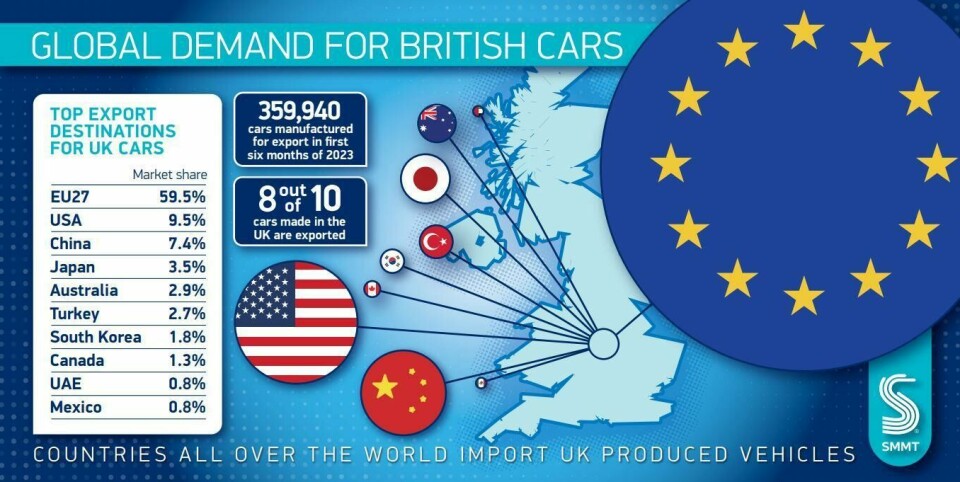UK supply chain strengthened by EU exports, but rules of origin risks remain for EVs
The EU remains the UK’s largest export market, accounting for 59% of all British car shipments, according to the Society of Motor Manufacturers and Traders (SMMT), but risks such as looming Rules of Origin tariffs threaten future growth.
In its most recent UK car manufacturing data for the first half of the year, the UK exported 214,017 units to the EU so far in 2023, up 11.2% year-over-year, according to SMMT, with imports of EU-built vehicles also rising. EV sales and production also showed growth. However, rising trade could be damaged should the UK and EU not find a compromise on impending Rules of Origin requirements related to battery and electrified vehicle manufacturing.
Mike Hawes, chief executive of SMMT, stressed that it will be “essential” for the bilateral trading relationship to be safeguarded.
Higher tariffs are due to come into force in less than six months’ time as part of the UK-EU Brexit trade deal and could see charges being applied to UK-made electric vehicles being exported if they do not meet the requirement that at least 40% of their components’ value is from the UK or the EU. This limit is currently difficult to reach, as the UK does not have an indigenous battery manufacturing and supply chain sector, and there is still limited capacity in the EU.

Carmakers including Ford and Stellantis have called for delays to the provision until at least 2027, however thus far there has been no change indicated by the European Commission. Electric vehicles built in the EU would also be subject to the tariffs when exporting to the UK, however not when trading EVs within the EU single market.
The SMMT have been calling for the government to provide an industrial strategy to aid the UK automotive supply chain in its transition to EVs, particularly when it comes to the Rules of Origin tariffs.
Mike Hawes told Automotive Logistics that there are ways to help reach the Rules of Origin thresholds, but that it will be difficult to attract this investment quickly without government support. “Essentially, you want to try to embed the most valuable elements of the [battery supply chain] process in the UK because that helps you get to those Rules of Origin thresholds much more easily,” he said, highlighting active materials such as anode and cathode-processing as examples.
“The Rules of Origin have the potential to levy a 10% tariff, not on petrol or diesel cars or vans, but on pure electric vehicles, which would be exactly what we don’t want when we’re trying to transition the market to electrification. When you consider that Europe is our biggest market for EV exports, the impact that [the tariffs] would have is significant.”
He added that while the recently announced multi-billion Tata Group gigafactory will be “a shot in the arm” for the UK supply chain, the industry will still need a solution to the potential tariffs.

The SMMT has been attempting to push back the implementation of the Rules of Origin until 2027, but Hawes said it is important that it is not a “Christmas Eve deal”, referring to the last-minute passage of the EU-UK trade deal at the end of 2020.
He said: “We are talking to our European counterparts, and they all want what we want, which is to effectively suspend the new Rules of Origin through to 2027. But the EU Commission is unpersuaded of that at the moment. I can’t tell you why, because I don’t know why. We need to find a pragmatic solution. The UK government is firmly supportive of us in that ambition, but we need to find the solution quickly.”
Speaking about the much-anticipated government industrial strategy, he said: “We expect there will be a more formal response in the autumn, I suspect in September. Again, we’re still waiting, but certainly I know that they are determined to have something, I wouldn’t call it an industrial strategy, but an automotive strategy for advanced manufacturing. There will be substance to it, and the government will want to try to ensure that it meets the expectations of the manufacturing industry.”

Elsewhere, Hawes said energy costs and skills shortages could threaten the UK’s automotive supply chain. “Firstly, we need lower energy costs. We’ve got a grid which is increasingly decarbonizing, which is great, but it needs to be more affordable,” he said.
He added: “Logistics costs have gone up significantly since Covid, and the Brexit effect means I’ve heard anecdotal stories of trucks going in full of parts and going out empty, which makes it more expensive, and the movement of goods is by no means easy. We’re at the end of the chain because we’re an island, so that doubles the difficulty, and then you add on the complexities of the administration.”
He added that while he couldn’t name the OEM, a carmaker queried how to “Kaizen” the additional logistics costs “out of the equation”.
On the issue of skills and labour, Hawes said: “We always need to get more people, but the primary issue is the changing skillset we need in terms of the transition to EVs. We’ll retain 80% of the people we need over the next five to eight years, but we need to skill them up for these new EV technologies.”





